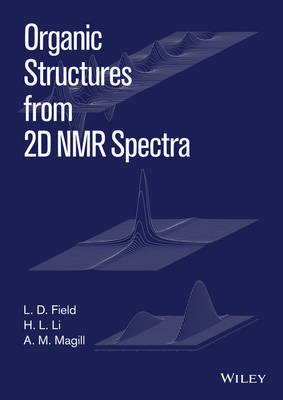
Organic Structures from 2D NMR Spectra
John Wiley & Sons Inc (Verlag)
978-1-118-86894-2 (ISBN)
The derivation of structural information from spectroscopic data is now an integral part of organic chemistry courses at all Universities. Over recent years, a number of powerful two-dimensional NMR techniques (e.g. HSQC, HMBC, TOCSY, COSY and NOESY) have been developed and these have vastly expanded the amount of structural information that can be obtained by NMR spectroscopy. Improvements in NMR instrumentation now mean that 2D NMR spectra are routinely (and sometimes automatically) acquired during the identification and characterisation of organic compounds.
Organic Structures from 2D NMR Spectra is a carefully chosen set of more than 60 structural problems employing 2D-NMR spectroscopy. The problems are graded to develop and consolidate a student’s understanding of 2D NMR spectroscopy. There are many easy problems at the beginning of the collection, to build confidence and demonstrate the basic principles from which structural information can be extracted using 2D NMR. The accompanying text is very descriptive and focussed on explaining the underlying theory at the most appropriate level to sufficiently tackle the problems.
Organic Structures from 2D NMR Spectra
Is a graded series of about 60 problems in 2D NMR spectroscopy that assumes a basic knowledge of organic chemistry and a basic knowledge of one-dimensional NMR spectroscopy
Incorporates the basic theory behind 2D NMR and those common 2D NMR experiments that have proved most useful in solving structural problems in organic chemistry
Focuses on the most common 2D NMR techniques – including COSY, NOESY, HMBC, TOCSY, CH-Correlation and multiplicity-edited C-H Correlation.
Incorporates several examples containing the heteronuclei 31P, 15N and 19F
Organic Structures from 2D NMR Spectra is a logical follow-on from the highly successful “Organic Structures from Spectra” which is now in its fifth edition. The book will be invaluable for students of Chemistry, Pharmacy, Biochemistry and those taking courses in Organic Chemistry.
Also available: Instructors Guide and Solutions Manual to Organic Structures from 2D NMR Spectra
Professor Leslie D. Field, Professor of Chemistry, University of New South Wales, Australia, has built up an international reputation for his research on novel reagents containing coordinatively unsaturated transition metals and for his extensive work in the field of NMR spectroscopy including novel studies on heteronuclear coherence transfer and multiple quantum NMR. Field was Professor of Organic Chemistry at the University of Sydney 1990 to 2005 and Head of the School of Chemistry from 1997 to 2001. He has also been the Deputy Vice Chancellor (Research) at UNSW since April 2005. Dr Alison Magill is a Postdoctoral Research Associate in the Field Group in the School of Chemistry, UNSW, with main areas of research in organometallic chemistry, catalysis and NMR spectroscopy, with a particular focus on the activation and functionalisation of small molecules such as carbon dioxide (CO2) and nitrogen (N2). Dr Hsiu Lin Li is a Postdoctoral Research Associate in the Field Group in the School of Chemistry, UNSW, with main areas of research in organometallic chemistry, catalysis and NMR spectroscopy, with a particular focus on the activation and functionalisation of small molecules such as carbon dioxide (CO2) and nitrogen (N2).
Preface vii
List of Figures xi
List of Tables xv
1 NMR Spectroscopy Basics 1
1.1 The Physics of Nuclear Spins 1
1.2 Basic NMR Instrumentation and the NMR Experiment 4
2 One-Dimensional Pulsed Fourier Transform NMR Spectroscopy 5
2.1 The Chemical Shift 7
2.2 1H NMR Spectroscopy 9
2.2.1 Chemical Shifts in 1H NMR Spectroscopy 9
2.2.2 Spin-Spin Coupling in 1H NMR Spectroscopy 10
2.2.3 Decoupling in 1H NMR Spectroscopy 15
2.2.4 The Nuclear Overhauser Effect in 1H NMR Spectroscopy 16
2.3 Carbon-13 NMR Spectroscopy 16
2.3.1 Decoupling in 13C NMR Spectroscopy 17
2.3.2 Chemical Shifts in 13C NMR Spectroscopy 18
2.4 Fluorine-19 NMR Spectroscopy 19
2.5 Phosphorus-31 NMR Spectroscopy 22
2.6 Nitrogen-15 NMR Spectroscopy 23
3 Two-Dimensional NMR Spectroscopy 25
3.1 General Principles 25
3.2 Proton-Proton Interactions 28
3.2.1 Correlation Spectroscopy – The COSY Experiment 28
3.2.2 Total Correlation Spectroscopy – The TOCSY Experiment 30
3.2.3 Nuclear Overhauser Spectroscopy – The NOESY Experiment 31
3.3 Carbon-Carbon Interactions 35
3.3.1 The INADEQUATE Experiment 35
3.4 Heteronuclear Correlation Spectroscopy 37
3.4.1 Heteronuclear Single Bond Correlation – The HSQC, HMQC and me-HSQC Experiments 37
3.4.2 Heteronuclear Multiple Bond Correlation – HMBC 38
4 Miscellaneous Topics 45
4.1 NMR Solvents 45
4.2 Reference Compounds and Standards 47
4.3 Dynamic Processes 48
4.3.1 Protons on Heteroatoms 49
4.3.2 Rotation about Partial Double Bonds 50
4.4 Second-Order Effects 51
4.5 Effect of a Chiral Centre on NMR Spectra 51
5 Worked Examples 55
5.1 General Principles 55
5.2 Worked Example 1 57
5.3 Worked Example 2 63
Problems 71
Index 309
| Erscheint lt. Verlag | 29.5.2015 |
|---|---|
| Verlagsort | New York |
| Sprache | englisch |
| Maße | 208 x 295 mm |
| Gewicht | 862 g |
| Themenwelt | Medizinische Fachgebiete ► Radiologie / Bildgebende Verfahren ► Kernspintomographie (MRT) |
| Naturwissenschaften ► Chemie ► Analytische Chemie | |
| ISBN-10 | 1-118-86894-3 / 1118868943 |
| ISBN-13 | 978-1-118-86894-2 / 9781118868942 |
| Zustand | Neuware |
| Haben Sie eine Frage zum Produkt? |
aus dem Bereich


